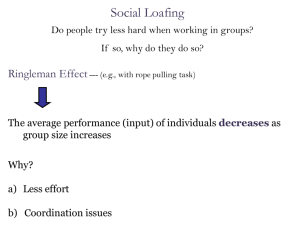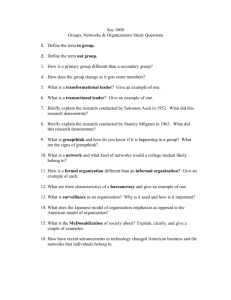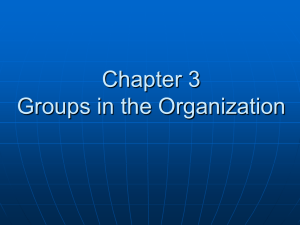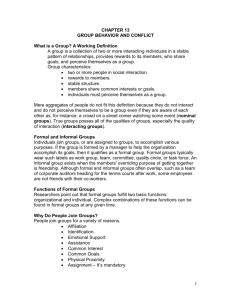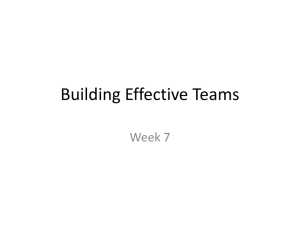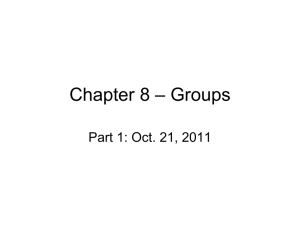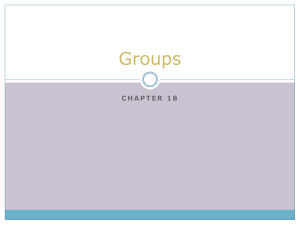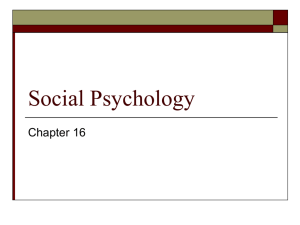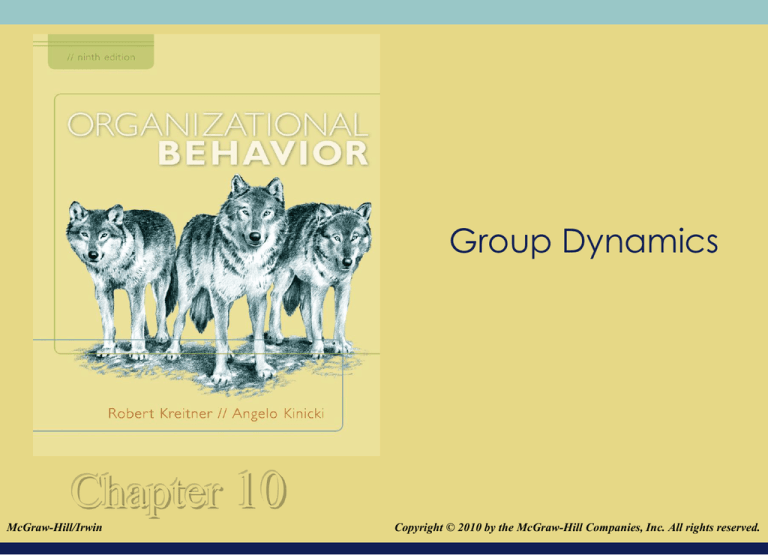
Group Dynamics
Chapter 10
McGraw-Hill/Irwin
Copyright © 2010 by the McGraw-Hill Companies, Inc. All rights reserved.
© 2008The McGraw-Hill Companies, Inc. All rights reserved.
Ch. 10 Learning Objectives
1. Identify the four sociological criteria of a group and
discuss the impact of social networking on group
dynamics.
2. Describe the five stages in Tuckman’s theory of
group development, and discuss the threat of group
decay.
3. Distinguish between role conflict and role ambiguity
4. Contrast roles and norms, and specify four reasons
norms are enforced in organizations.
5. Distinguish between task and maintenance functions
in groups.
10-2
Ch. 10 Learning Objectives
6. Summarize the practical contingency
management implications for group size.
7. Discuss why managers need to carefully
handle mixed-gender task groups.
8. Describe groupthink, and identify at least
four of its symptoms
9. Define social loafing, and explain how
managers can prevent it.
10-3
Key Social Skills Managers Need for
Building Social Capital
Social Skill
Description
Social perception
Ability to perceive accurately the
emotions, traits, motives and
intentions of others
Impression management
Tactics designed to induce liking a
favorable first impression by
others
Persuasion and social
influence
Ability to change others’ attitudes
and/or their behavior in desired
direction
Ability to adapt to, or feel
comfortable in, a wide range of
social situations
Social adaptability
10-4
Your Experience
What types of groups have you belonged to?
a. Class group projects
b. Groups whose members share an common
recreational interest or hobby
c. Student organizations
d. Other
What made this experience rewarding?
What made this experience challenging?
10-5
Sociological Criteria of a Group
Common
identity
4
Collective
norms
2
1
Two or more
Freely interacting
individuals
3
Collective goals
10-6
Value of Groups
Why do
individuals join
groups?
Why do
organizations
form groups?
10-7
Formal Groups Fulfill Organizational
Functions
1) Accomplish complex, independent tasks
beyond the capabilities of individuals
2) Generate new or creative ideas or
solutions
3) Coordinate interdependent efforts
4) Provide a problem-solving mechanism
for complex problems
5) Implement complex decisions
6) Socialize and train newcomers
10-8
Formal Groups Fulfill Individual Functions
1) Satisfy the individual’s need for affiliation
2) Develop, enhance and confirm individual’s
self-esteem and sense of identity
3) Give individuals an opportunity to test and
share their perceptions of social reality
4) Reduce the individual’s anxieties and feelings
of insecurity and powerlessness
5) Provide a problem-solving mechanism for
social and interpersonal problems
10-9
Social Networking Revolution
Social networking
sites are:
•Breaking down silos
•Blurring the lines
between formal and
informal groups
•Enabling friendships
between managers
and subordinates
What management
challenges does this
create?
How can SNS’s be used
to the organization’s
benefit?
Should managers be
friends with direct
reports?
10-10
Tuckman’s Five-Stage Theory
of Group Development
Performing
Adjourning
Norming
Storming
Forming
Return to
Independence
Dependence/
interdependence
Independence
10-11
Tuckman’s Five-Stage Theory
of Group Development
Forming
Individual
Issues
Group
Issues
Storming
Norming
“How do I fit
in?”
“What’s my
role here?”
“What do the
others expect
me to do?”
“Why are we
here?”
“Why are we
fighting over
who’s in
charge and
who
does what?”
“Can we agree
on roles and
work as a
team?”
Performing
“How can I
best
perform my
role?”
“Can we do
the
job properly?”
10-12
Test Your Knowledge
True or False?
1. All groups go through the stages in this order and
don’t regress to earlier stages.
2. Knowledge of these stages helps members and
leaders understand the group’s behavior and take
appropriate action.
3. Participative leadership is more important in earlier
stages, while structured leadership is more
important in later stages.
4. Feedback becomes more general, less frequent, and
more negative as teams progress through the stages.
5. Unclear deadlines make work teams less efficient.
10-13
Roles Defined
Role expected
behaviors for a
given position
Examples:
• Team Leader
• Devil’s Advocate
• Business
Developer
10-14
A Role Episode
Role Sender
• Perceived organizational/
group requirements
• Comparative evaluation of
- Role expectations for
focal person
- Focal person’s behavior
Focal Person
Role
Modeling
• Perceived role expectations
• Experienced role overload,
role conflict, role ambiguity
Communication
• Constructive/destructive
of approval
responses
or need for
change
Feedback
10-15
Roles Defined
Role Conflict: others have conflicting or
inconsistent expectations
Role Ambiguity: Confusion arising from not
knowing what one is expected to do as the holder of a
role.
Role Overload: others’ expectations exceed one’s
ability
What is the impact of these outcomes?
What can managers do about it?
10-16
Norms
Norm shared
attitudes, opinions,
feelings, or actions
that guide social
behavior
In what four ways
are norms formed?
10-17
Four Reasons Norms are Enforced
Group/organization survival
Clarification of behavioral expectations
Avoidance of embarrassment
Clarification of central values/unique
identity
10-18
Task Roles
Initiator suggests new goals or ideas
Information seeker/giver clarifies key issues
Opinion seeker/giver clarifies pertinent values
Elaborator promotes greater understanding
through examples or exploration of implications
Coordinator pulls together ideas and suggestions
10-19
Task Roles
Orienter keeps group headed toward its stated
goal(s)
Evaluator tests group’s accomplishments with
various criteria such as logic and practicality
Energizer prods group
Procedural technician performs routine duties
Recorder performs a “group memory” function by
documenting discussion and outcomes
10-20
Maintenance Roles
Encourager fosters group solidarity by accepting and
praising various points of view
Harmonizer mediates conflict through reconciliation or
humor
Compromiser helps resolve conflict by meeting others
“half way”
Gatekeeper encourages all group members to
participate
Standard setter evaluates the quality of group processes
Commentator records and comments on group
processes/dynamics
Follower serves as a passive audience
10-21
Test Your Knowledge
Karen, a manager, would like to assemble a
group to make a difficult, complex decision.
Ken, wants to form a group to brainstorm
new product ideas. The optimal size for
Karen’s and Ken’s groups, respectively, is:
a.
b.
c.
d.
20-25, 4-5
10-15, 10-15
3-5, 8-12
8-12, 3-5
10-22
Categories of Sexual Harassment
Category
Behavioral Examples
Derogatory attitudes--impersonal
Obscene gestures not directed at
target
Sex-stereotyped jokes
Derogatory attitudes--personal
Obscene phone calls
Belittling the target’s competence
Unwanted dating pressure
Repeated requests to go out after
work or school
Sexual propositions
Proposition for an affair
10-23
Categories of Sexual Harassment
Category
Physical sexual contact
Behavioral Examples
Embracing the target
Kissing the target
Physical nonsexual contact
Congratulatory hug
Sexual coercion
Threatening punishment unless
sexual favors are given
Sexual bribery
10-24
Threats to Group Effectiveness
Asch Effect
Groupthink
Social Loafing
10-25
The Asch Effect
Asch Effect: the distortion of individual
judgment by a unanimous but incorrect
opposition.
Standard Line Card
?
Comparison Lines
Card
1
2
3
10-26
Asch Effect
Since the 1950’s this effect has declined in the
US
Individualist cultures resist pressures to
conform more than collectivistic cultures
What are the implications of the Asch effect
for managers?
10-27
Groupthink
Groupthink: When you
feel a high pressure to
conform and agree and
are unwilling to
realistically view
alternatives
What are some of the
reasons or factors that
promote groupthink?
What can be done to
prevent groupthink?
10-28
Symptoms of Groupthink Lead to
Defective Decision Making
Symptoms of Groupthink
Invulnerability
Inherent morality
Rationalization
Stereotyped views of
opposition
Self-censorship
Illusion of
unanimity
Peer pressure
Mindguards
Decision-making Defects
1) Few alternatives
2) No reexamination of
preferred alternatives
3) No reexamination of
rejected alternatives
4) Rejection of expert
opinions
5) Selective bias of new
information
6) No contingency plans
10-29
Social Loafing
Social Loafing:
decrease in individual
effort as group size
increases
What factors
contribute to social
loafing?
What actions could
you take to prevent
social loafing?
10-30
Test Your Knowledge
A group of employees with accounting expertise
needs to adapt their procedures in response to
changes within the organization. The group decides
to 1) hold each member accountable for a
meaningful task and 2) to establish a process so that
everyone openly expresses their opinion. The group
was trying to prevent ____ and _____, respectively.
a.
b.
c.
d.
Social loafing; Groupthink
Role overload; social loafing
Asch Effect; role ambiguity
Groupthink; role overload
10-31

